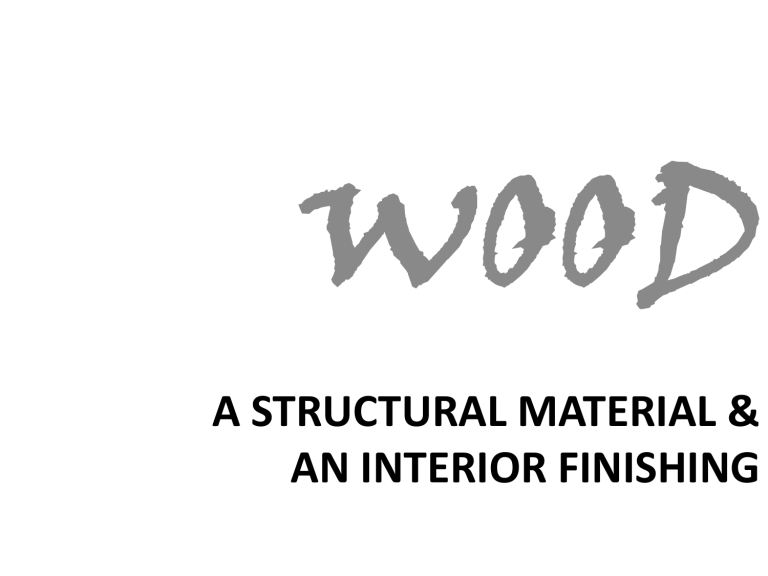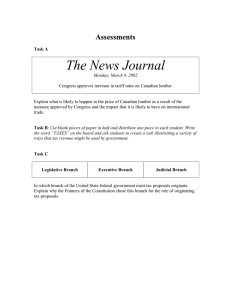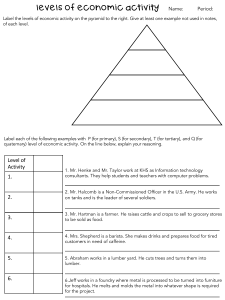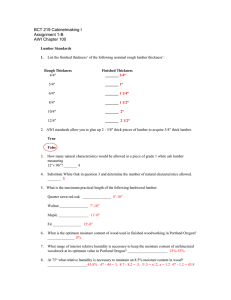
WOOD A STRUCTURAL MATERIAL & AN INTERIOR FINISHING WOOD It is a construction component From a TREE - It is the tough fibrous cellular substance that makes up most of the stems and branches of trees beneath the bark Parts of a Tree Crown, the leaves and living branches of a tree Trunk, the main stem of a tree apart from its branches and roots Natural Wood has certain properties that make it an attractive building material: 1. Natural Warmth, to touch; would insulates (to prevent or reduce passage of heat) 2. Workability, easily shaped with simple tools 3. Infinite variety; no trees, or even pieces from same tree, are alike 4. Strength-to-weight ratio for bridges, boats, homes and furniture 5. Flexibility; watch how huge trees bend before the wind 6. Fire Protection; wood chars and therefore burns slowly, doesn’t melt or crumble 7. Color; natural, through wood’s ability to receive many types of stains and finishes Classification of Wood: Woods can be generally classified into two: SOFTWOOD - comes from conifers (evergreens) which have needles (pointed leaf) instead of leaves Conifer, any of various predominantly evergreen, conebearing trees, as pine, fir, hemlock, and spruce Evergreen, having foliage that remains green and functional throughout the year or through WOOD Softwood DESCRIPTION Pine and other softwoods come from coniferous trees Easy to scratch and dent compared to hardwood Has wider grain Heat and moisture can cause cracking and warping OPTIONS CARE & MAINTENANCE Can be stained or painted Generally light color Use mild diluted detergent and damp cloth Avoid abrasives Use no-wax polish Classification of Wood: Woods can be generally classified into two: HARDWOOD - comes from the broad-leaved flowering or deciduous trees such as cherry, maple or oak Deciduous, means shedding leaves annually or at the end of a growing season most Philippine timber are of this kind WOOD Hardwood DESCRIPTION Used as frames for its compressive strength OPTIONS Can be stained or painted or pickled Moisture can Large selection cause to warp of door styles and shrink Example is Tanguile CARE & MAINTENANCE Use mild diluted detergent and damp cloth but not abrasives Use no-wax polish Classification of Wood: Woods can be generally classified into two: Notes: The term “hardwood” and “softwood” are often misleading because they have no direct relation to the actual physical hardness or softness of the wood In certain types, a hardwood may actually be softer than a softwood Structure of Wood: Structure of Wood: SAPWOOD (Alburnum) -it is the softer, younger outer portion of a tree that lies between the cambium(formative layer just under the bark) and the Heartwood -the portion near the periphery (near the boundary), area around the edge -contains the living cells and takes an active part in the life process of a tree -it is more permeable (allows liquid, gasses to pass through) and less durable because it contains more organic matter than the central core of the log, it is more susceptible to blueing fungi and wood-boring insects -usually lighter in color than the heartwood (central portion) Structure of Wood: HEARTWOOD (Duramen) -the older, harder central portion of a tree -the central core of the log -usually contains deposits of various materials that frequently give darker color than the sapwood -it is denser (tight, close together wherein it is difficult to pass through), less permeable and more durable than the surrounding sapwood -more expensive because of the age which makes it stronger Structure of Wood: Bark, the tough external covering of a woody stem, branch, or root, composed of a living inner layer called phloem and an outer bark of corky, dead tissue Phloem, a layer of tissue that carries food from the leaves to the growing parts of a tree Cambium, a thin layer of reproductive tissue between the phloem and xylem, which produces new phloem on the outside and new xylem on the inside of stems, branches, and roots Pith, the soft, central core about which first growth takes place in a newly formed stem Structure of Wood: Properties of Wood: a. Hardness - this is measured by compression which a piece of timber undergoes when a weight is applied to it b. Flexibility - the amount of piece will bend before breaking - softwoods are generally brittle (hard) while hardwoods are flexible c. Strength d. Durability - it will long last Note: Woods can deteriorate Classification of Lumber: TIMBER (Troso) - wood suitable for use as a building material for construction - Log, a length of trunk or large limb of a felled tree, ready for sawing Classification of Lumber: LUMBER (Tabla) - it is the wood term used in construction - the Timber product manufactured by sawing, re-sawing, passing lengthwise through a planning machine, crosscutting to length and grading - therefore it is a processed wood - it is classified by its size or dimensions measured in inches ex: a piece of lumber measuring 2 inches by 4 inches is called, 2”X4” - generally they are available in even-numbered widths: 4, 6, 8, 10, 12 inches Lumber Rough Lumber - is a lumber that is saw, edged and trimmed but not surfaced nominal shapes Lumber Dressed Lumber - is a lumber that is surfaced with planning machine to attain a smooth surface and uniform size “S1S” – dressed one side; used for framing “S2S” - dressed lumber smooth on 2 sides; used for framing “S4S“- dressed lumber smooth on 4 sides; often used for parts with exposed sides and carving details Note: It cost slightly more than rough Classifications of Lumber: There are four available classifications: A. STRIPS - lumber less than 2” thick and less than 8” wide WOOD STRIP FLOORING Classification of Lumber: B. BOARD LUMBER - pieces less than 2” thick and at least 8” wide graded for appearance rather than strength - usually used for sidings and flooring Classification of Lumber: C. PLANKS/ JOISTS - wide pieces of lumber 2” to 5” thick - used for stair stringers and treads, floor girders, roof girts and trusses Classification of Lumber: D. DIMENSION LUMBER - pieces more than 2” and less than 5” in any dimension - classified for strength rather than appearance - usually used for purlins, joists and wall framing Note: of the above, the two most common classifications are Dimension and Board Lumber Dimension Lumber Lumber Measure: It is important to realize that the stated size of lumber is not its actual finished size NOMINAL SIZE - is the size of lumber when it is cut from the log - the dimension of lumber before drying and surfacing ACTUAL SIZE - after cutting, the lumber is dried and then planed on all four sides to achieve smoothness - the finish size is therefore smaller - also called dressed dimension Lumber Measure: NOMINAL SIZE ACTUAL/ DRESSED SIZE For Dimension Lumber: 2 x 4 1½ x 3½ 2 x 6 1½ x 5½ 2 x 8 1½ x 7½ 2 x 10 1½ x 8½ 2 x 12 1½ x 11½ For Board Lumber: 1 x 4 ¾ x 3½ 1 x 6 ¾ x 5½ 1 x 8 ¾ x 7½ 1 x 10 ¾ x 9½ 1 x 12 ¾ x 11½ Lumber Measure: - lumber is sold in lengths from 6’ up to 20’ in increments of 2’ - special lengths greater than 20’ are also available but cost more per board foot than the standard lengths (available but not common) Board Measure, lumber measurement in board feet - BOARDFOOT, a unit quantity for lumber equal to the volume of a piece whose nominal dimensions are 12” square and 1” thick - which maybe described as the measure of a piece of wood 1” thick, 12” wide (or 1’) and 12” long Lumber Measure: Board Foot = Thickness (in) x Width (in) x Length (ft) _________________________________________ 12 - Generally used only for framing lumber - Mouldings and Millworks are computed and sold by Linear Foot Board Foot Example: Compute the number of board feet: a. A piece of 1” x 8” x 10’ strip lumber 1pc x 1” x 8” x 10’ ----------------------12 = 6.67 or 7 bd. ft. Conversion Meter to Feet: X 3.28 Ex: 3 meters X 3.28 = 9.84 feet Feet to Meter: / 3.28 or X .30 Ex: 50 feet /3.28 = 15.24 or 15 meter Sq.m to Sq.ft: X 10.7584 Ex: 120 sq.m X (3.28)² 10.7584 = 1,291 sq.ft Board Foot b. 10 pcs of 2” x 6” x 8’ c. 5 pcs of 1” x 4” x 3m d. 20 pcs of 1” x .20m x 12’ LUMBER Three Categories of Lumber 1. Yard Lumber - Intended for general building purposes - Used for ordinary light construction and finishing work - Including boards, dimension lumber, and timbers - 2”X2” to 2”X12” LUMBER Three Categories of Lumber 2. Shop/ Factory Lumber - lumber sawn or selected primarily for further manufacture, graded according to the amount of usable wood that will produce cuttings of a specified size and quality - intended for use in shop or mill makers - sash, doors and cabinets Ex: T&G, S-cut (stone cut), V-cut, Bead and moldings like convex, concave and quarter round LUMBER 2. Shop/ Factory Lumber Matched Lumber, lumber having edges dressed and shaped to form a tongue and- groove joint when in laid edge to edge or end to end Patterned Lumber, lumber dressed and shaped to a pattern or molded form LUMBER Three Categories of Lumber 3. Structural Lumber - used in heavy construction for load-bearing purposes and is cut into timbers of large size - it is made from the heartwood of the log - for beams, stringers, and posts WOOD GRAINS (haspe) Main Types of Wood Grain Structure 1. Straight Grain - fibers running in the same direction as the main axis of the tree a. Edge Grain (vertical grain) annual rings run approximately at right angle to the face b. Flat Grain - when the annual rings run more or less parallel to the surface Main Types of Wood Grain Structure 1. Straight Grain c. Angle Grain (indefinite grain) - when the annual rings are about 45 degrees to the face Main Types of Wood Grain Structure 2. Inter-locked grain - grains are in successive layers and in opposite direction 3. Wavy or Curly grain - constantly changing in orientation so that a line drawn parallel to their direction appears as wavy ins Wood Defects - Every tree is a prey to defects from the moisture content it emerges as a seedling to the last stages of seasoning, and these defects can be innate (inherent vice), such as the characteristic natural shrinkage of wood: acquired defects occasioned by seasonal checks, insect and fungal attack, etc. and artificial defects caused by incorrect sawing and seasoning - As, however, any one defect may arise from several causes it is more convenient to classify them as natural and artificial. Natural Defects: - Emerges even in the early stages as seedling to the last stage of seasoning, can be innate - Natural shrinkage - Acquired defects by seasonal checks - Insect and fungal attack Defects of Wood: Decay -caused by attack of fungi Defects of Wood: CHECKS - cracks or lengthwise separation across the annual rings of growth caused by irregular shrinkage during drying - checks are formed when the circumference shrinks more than the interior section of the log Defects of Wood: SHAKES - these are cracks between and parallel to the annual rings of the growth, a natural split - Both the medullary ray and springwood cells of ring-porous hardwoods are weaker than the remainder, and built-in tensions are created which tend to level out, either in the growing tree under certain adverse conditions or in the felled tog during seasoning - Thus extensive splitting may occur in the weakest links Shakes Various forms of shakes are common, as follows 1. Radial shakes - the log splits from pith or heart radially along the medullary rays, usually indicating that the tree has passed its prime - sawing losses can be minimized by placing the cuts either side of the shake, always provided the growth of the tree does not twist upon its axis, in which case the shake become spiral, rendering the log useless for long lengths. - where only one shake is present it is known as a simple “heart shake”, while two shakes in line impose a “double heart shake”, and several a “star shake” Various forms of shakes are common, as follows 2. Frost shakes - project inwardly from a definite frost rib on the cambium and are, as their name implies, the result of severe weather Various forms of shakes are common, as follows 3. Tangential shakes - the soft springwood of the log splits away from the harder summerwood caused by old age, excessive bending under string winds, intense heat, etc. - shakes run along part of the annual ring only - known as cup shakes - but when it is completely encircled then they become “ring shakes” Various forms of shakes are common, as follows 4. Cross shakes - the actual rupture is across the grain - cause by felling shatter (the sudden impact as the felled log hits either hard ground or another fallen log) - brittle heart or carrot heart Defects of Wood: KNOTS - these are irregular growths in the body of a tree which interrupts the smooth curve of the grain - the fibers of the tree are turned from their normal course and grow around the knot at the point of the tree Knots are graded as follows: a. Pin Knots - Small knots ½” or under, often caused by the shedding of early branches. Usually allowable in prime timber b. Spike or Splay Knots - Knots sliced through their length during sawing, and commonly known as ‘slash’ knots. They are difficult to plane up, especially in softwood, where large specimens are not permissible in unless allowed for in the measurement c. Encased knots - Dead knots which are still sound and difficult to dislodge, and often ringed with resin in softwood d. Branched knots - Two or three knots springing from a common center Defects of Wood: PITCHPOCKETS - these are well-defined openings between annual rings containing solid or liquid pitch - pitch veins - resin pockets - caused by damage to the cambium layer Defects of Wood: Pith Flecks - repeated damage to the cambium layer by small insects is often healed over with hark, and may show as small dots or patches of brown cork deeply buried - they have no other effect other than that of unsightliness Defects of Wood: Rind Galls, patches of ingrowing bark Internal Sapwood, dies ring by ring, forming heartwood Burls/ Burrs, twigs or witch’s broom Canker, cause by fungoid disease Cat Face, a partially heated fire scar Callus, tissue formed over a wound in a tree resulting unnatural growth incorporated in the normal wood growth Defects of Wood: Artificial Defects - all woods shrink on drying, thus creating internal strains and stresses - if structure is unequal or lacking in elasticity (innate defect) - incorrect seasoning imposes too great a strain, then various forms of distortion, splitting Defects of Wood: Artificial Defects WANE - this is the lack of wood on the edge or corner of a piece Defects of Wood: WARPING - any variation with the plane surface of the piece caused by unequal shrinkage of the board - there are several forms of warp: Defects of Wood: WARPING a. Crook a distortion of the board in which the edge is convex or concave longitudinal b. Bow - a distortion of the board in which the face is convex or concave longitudinal Defects of Wood: WARPING c. Springing - sometimes known as edge bend - the wood remains flat hut bends edgewise on its own plane Defects of Wood: WARPING d. Cup - a distortion of the board in which the face is convex or concave across the board - rounding e. Twist - a distortion of the board in which one corner is raised Methods of Sawing Wood: A log of wood can be cut into different ways to make lumber Plainsawing - refers to lumber cut tangent to the annual rings or growth or, in commercial practice, cut with annual rings at an angle 0 degrees to 45 degrees - plainsawn lumber is preferable when a pleasing pattern is required, as in wall paneling Methods of Sawing Wood: A log of wood can be cut into different ways to make lumber Quartersawing - refers to wood cut radially to the annual rings of growth parallel to the rays or, in commercial practice, cut with the annual growth rings at an angle 45 degrees to 90 degrees - quartersawn lumber is desirable because it has less shrinkage than plainsawn lumber, and this is important where joints must kept tight Riftsawing - very similar to quartersawn but different angle - refers to wood cut at a 30 degrees to 60 degrees angle to the center of the timber SEASONING of LUMBER Seasoning - the process of removing moisture from green wood (wood from freshly-cut logs) Fiber-saturation Point - remaining absorbed water - approximately 30% moisture content (M.C.) for all species Equilibrium Moisture Content (E.M.C.) - the condition of dryness of the wood - in the Philippines, this is equivalent to from 12 to 16 percent moisture content SEASONING of LUMBER it may be done by: a. AIR-DRYING (Natural or Sun Drying) - in which the lumber is exposed to the air - lumber is strip-piled at a slope on a solid foundation to allow air to circulate around every piece while sloping allows water to run off quickly a. AIR-DRYING (Natural or Sun Drying) SEASONING of LUMBER it will be done by: b. KILN-DRYING - in which warm moist air or superheated steam is used to heat the wood and drive out moisture - where lumber is artificially dried to the correct moisture content - used for more expensive lumber, required for more refined uses so as wood will not move like in furniture b. KILN-DRYING SEASONING of LUMBER Seasoned lumber has many advantages over green lumber: a. It lessens the liability of the wood to be attacked by the fungi causing blueing and decay, and some wood-boring insects b. Reduction of weight c. Increased strength d. Minimum shrinkage after the lumber is in place (thus avoids opening up joints in doors, windows, sidings, etc.) SEASONING of LUMBER Seasoned lumber has many advantages over green lumber: e. Reduced checking and warping f. Increased nail-holding power of the wood (nails do not hold well when driven into green or unseasoned lumber because of its softness) g. Improvement of the wood for the application of paint and to receive wood preservatives, fire retardants SEASONING of LUMBER The advantages of kiln-drying over air-drying are: a. Greater reduction in weight b. Control of moisture content to any desired value c. Reduction in drying time d. Killing of any fungi or insects e. Setting the resins in resinous wood f. Less degrade (degrade is the loss in quality during seasoning of the lumber through unequal shrinkage which causes checks and loosening of knots, warping) PRESERVATION of LUMBER - Wood can be treated to prevent or at least delay destruction by fungi, insects, bacteria, marine organisms, and fire. SEASONING of LUMBER Pressure Treated Lumbers - when lumber is subjected to pressure and injected with chemicals or salts to insure it from rots a. WOLMANIZED- Wolman Salt b. TANALIZED c. PERMANIZED d. BOLIDEN- patented lumber





